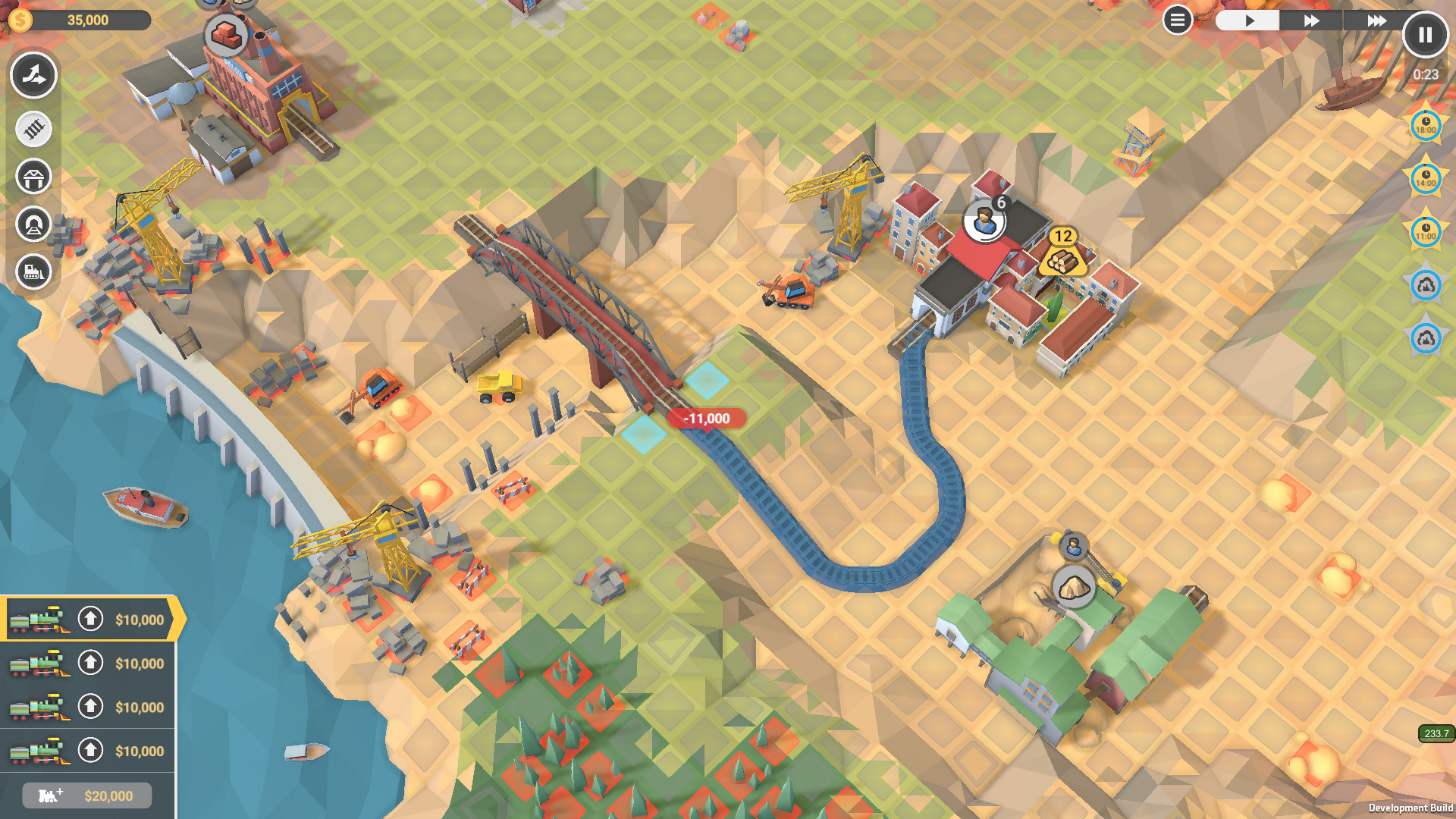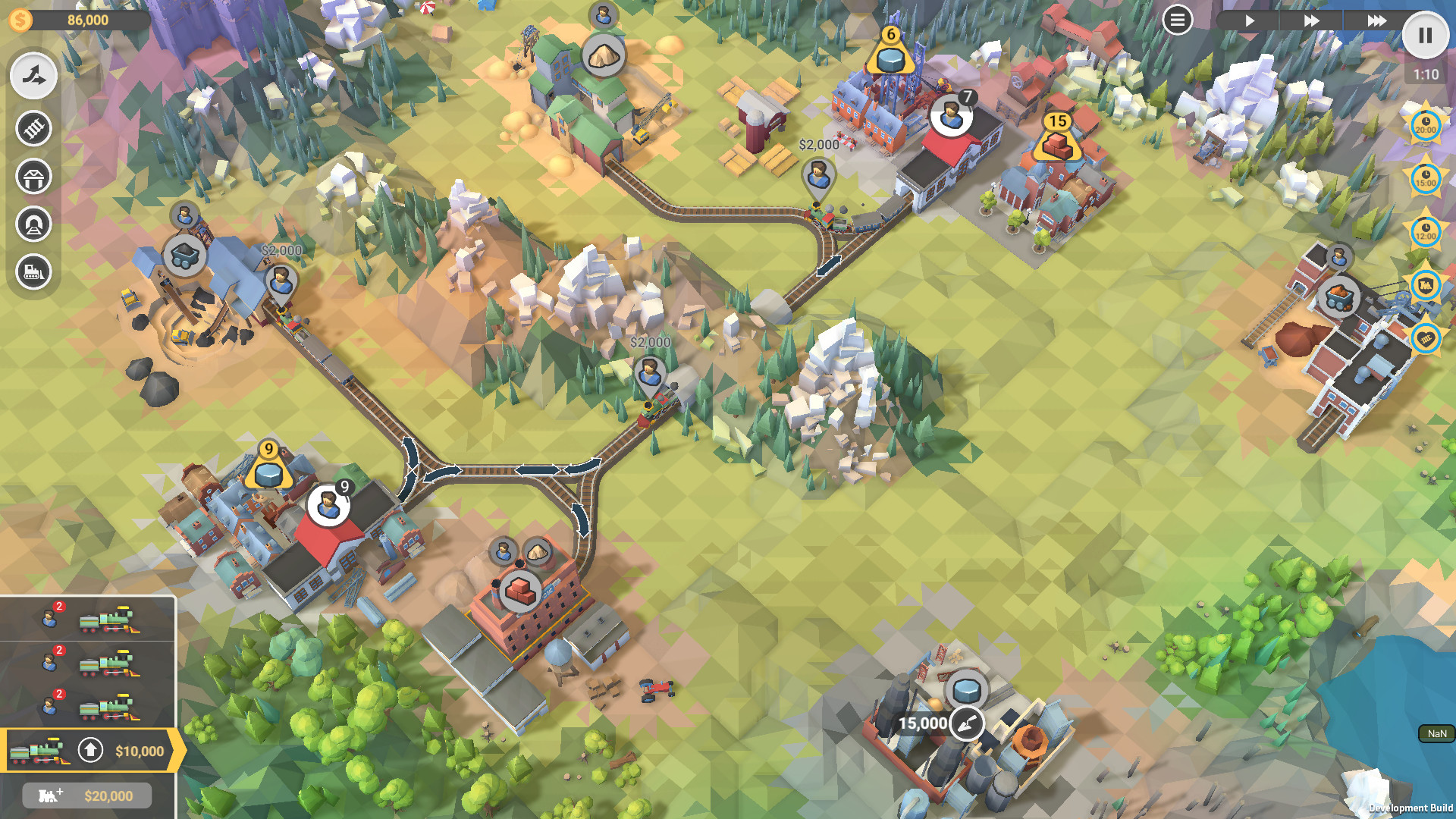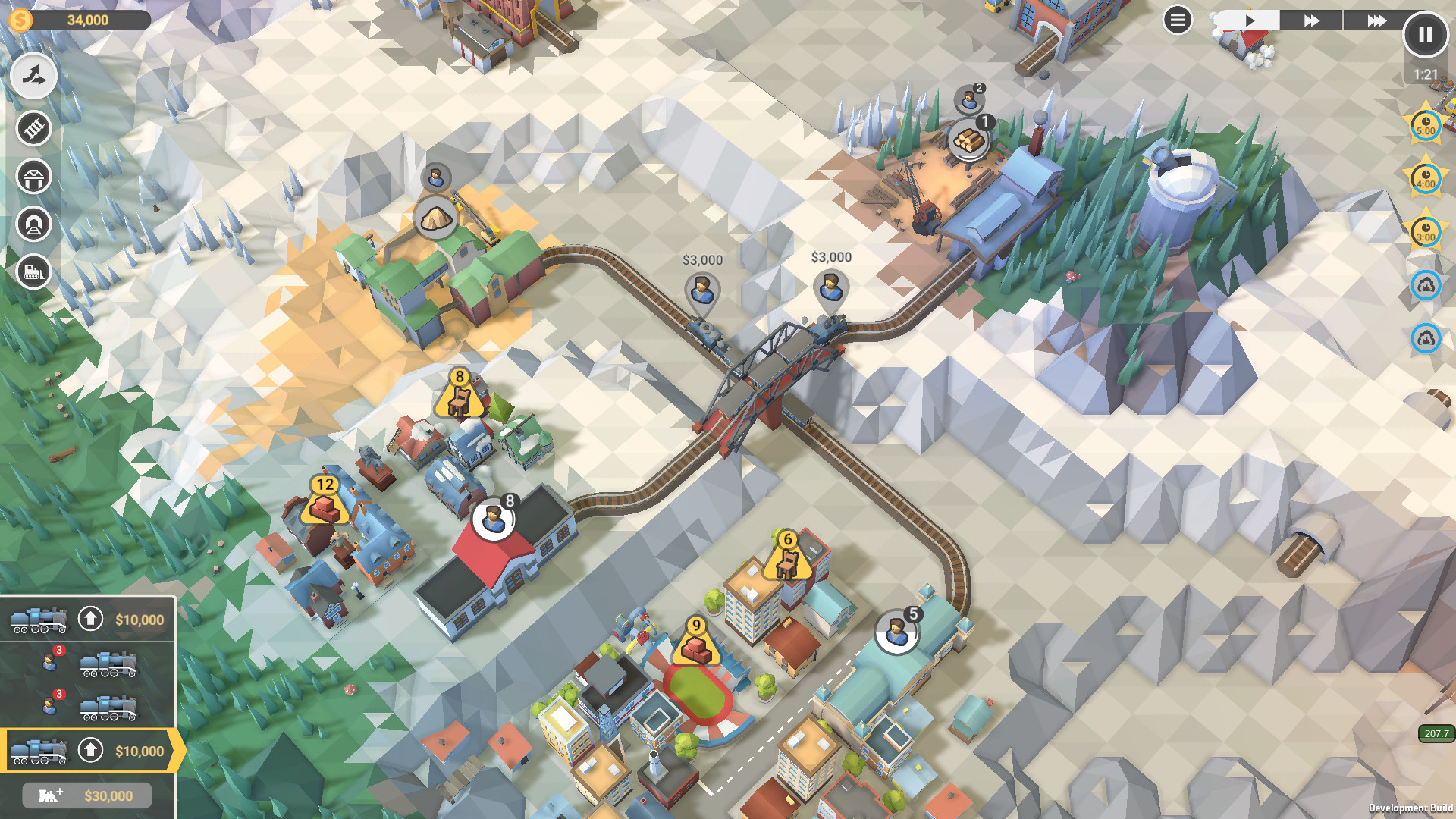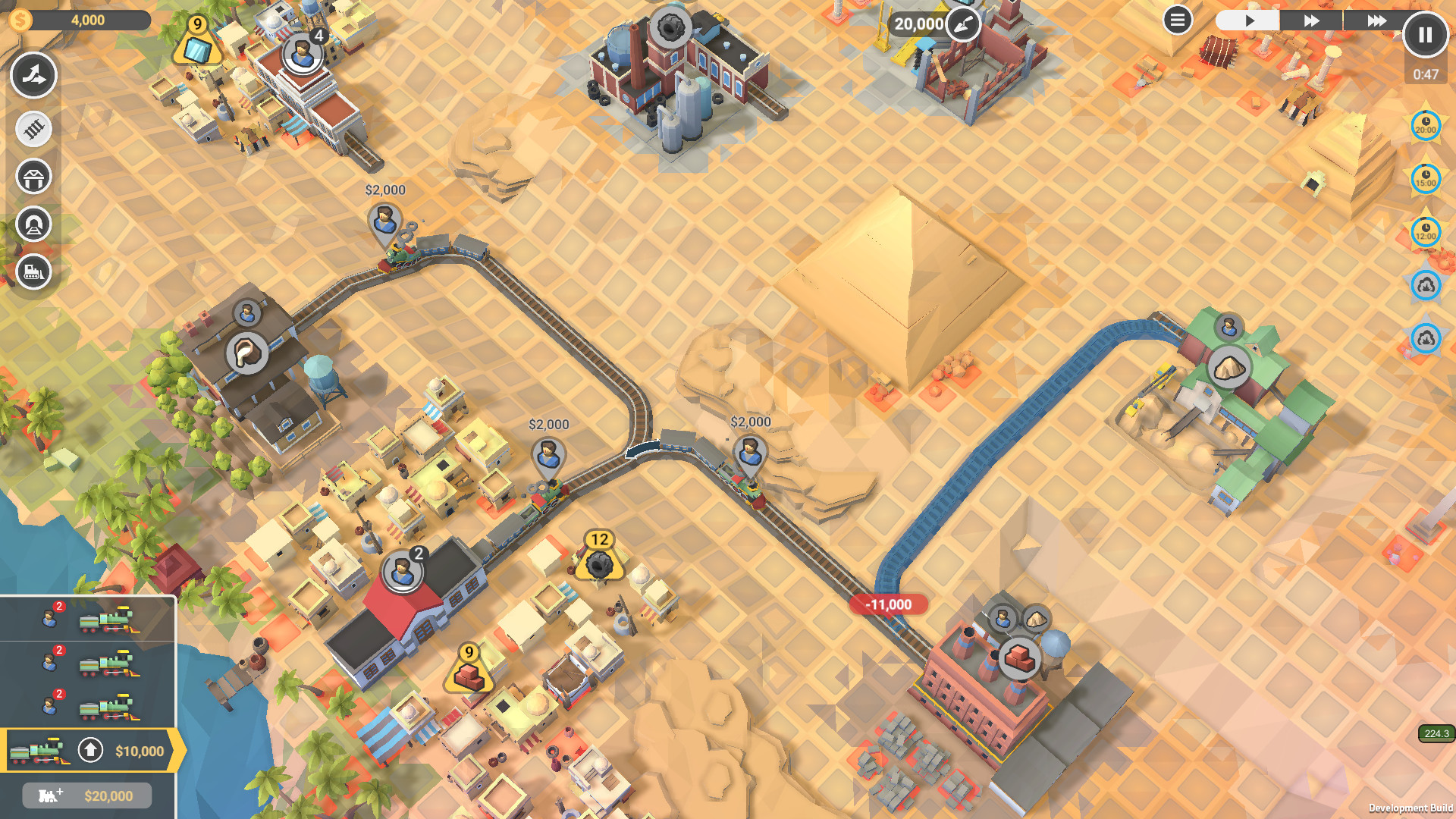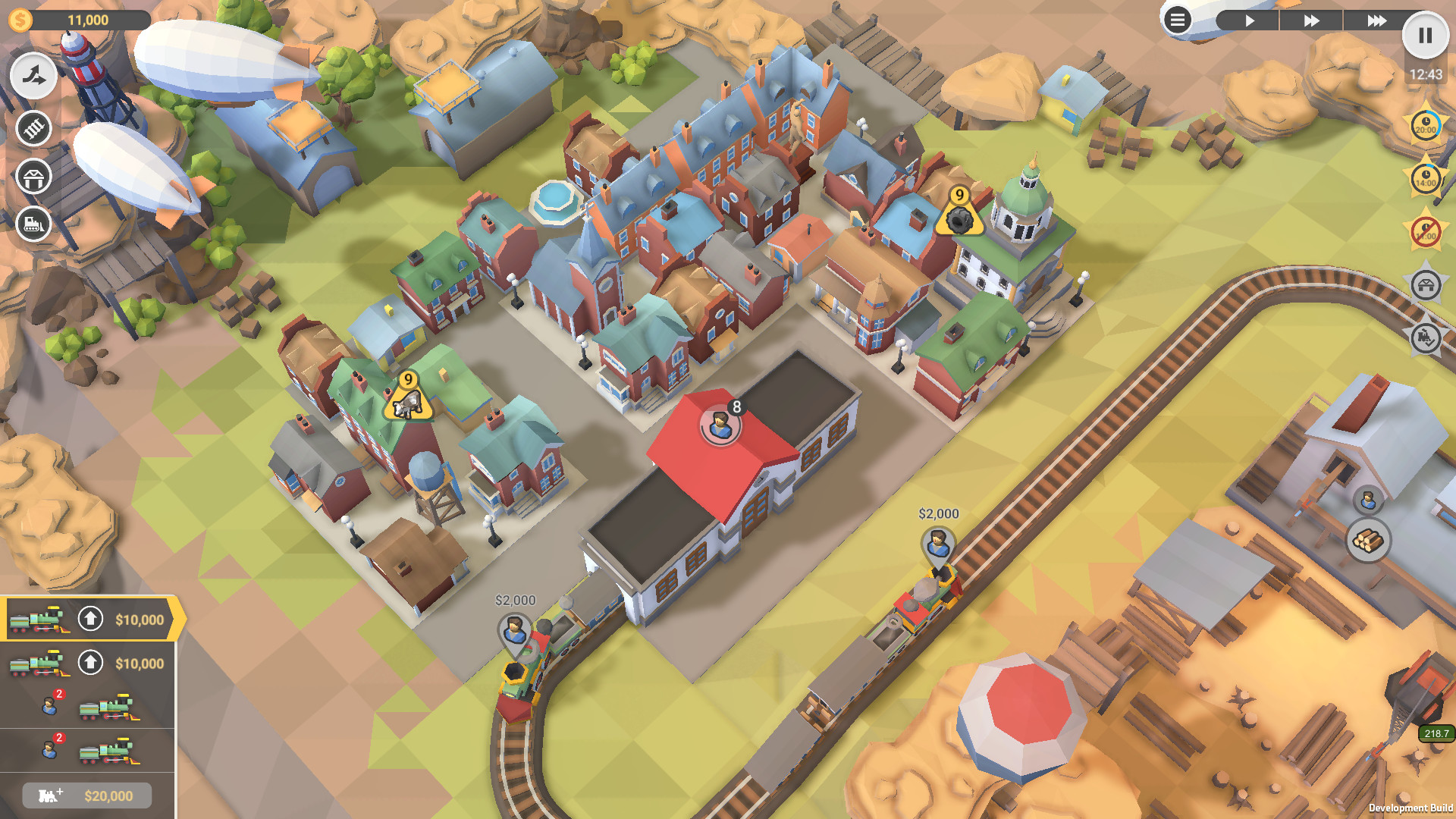Train Valley 2 is a train tycoon puzzle game. Take your railroad company from the days of the Industrial Revolution and into the future, meeting the needs of the valley's cities and industries. Build railroads, upgrade your locomotives, and keep your trains on schedule without delays or accidents. All aboard — the train is leaving the station!

Enjoy engaging and addictive gameplay, combining puzzle micromanagement with tycoon elements.

Discover the history of railroads in elegant low-poly graphics!

Keep your trains running on schedule across 50 levels in Company Mode (*the Early Access version currently offers 20).

Upgrade your stock of locomotives and acquire advanced engines, with 18 models to unlock (*the Early Access version currently features 4).

Produce and ship increasingly sophisticated goods in more than 35 types of train cars (*the Early Access version currently offers 21).

Jump into our Level Editor with Steam Workshop integration and create your own Valleys - or play levels from other players!

Create your own mods with custom locomotives, train cars, industries, and resources from your favorite time or universe.

Enjoy engaging and addictive gameplay, combining puzzle micromanagement with tycoon elements.

Discover the history of railroads in elegant low-poly graphics!

Keep your trains running on schedule across 50 levels in Company Mode (*the Early Access version currently offers 20).

Upgrade your stock of locomotives and acquire advanced engines, with 18 models to unlock (*the Early Access version currently features 4).

Produce and ship increasingly sophisticated goods in more than 35 types of train cars (*the Early Access version currently offers 21).

Jump into our Level Editor with Steam Workshop integration and create your own Valleys - or play levels from other players!

Create your own mods with custom locomotives, train cars, industries, and resources from your favorite time or universe.
Locomotive 3-8 (The Doctor)
Solid steel plows, snow throwers, flangers, snow melters, snow blowers powered by jet engines all exist and some are deployed every winter across the globe, yet the rotary snowplows still outperform the competition in both power-to-efficiency and spectacular snow removal nominations.
Several reasons for the forgotten part: advent of more ubiquitous service and construction vehicles like bulldozers and the sheer maintenance cost of a single unit - even if it isn't actively used, just stored.
Of course there are disadvantages too.
https://www.youtube.com/watch?v=RjBQ3MaBYiUVideo by Jake Miille Photography
Today these magnificent machines are used as a last resort, when less expensive fixed-blades are overwhelmed by especially large snow quantities, mainly around mountain passes and areas with poor road access, or areas with routine severe snowfall conditions.
 (SPMW 207 at Donner Pass, 2017 - photo by Mike Haire from Railroad Picture Archives )
(SPMW 207 at Donner Pass, 2017 - photo by Mike Haire from Railroad Picture Archives )
Notice the fold out "wings" on both sides of the blade assembly that allow the plow to grab more snow and clean a wider area.
Train Valley 2s in-game counterpart is called The Doctor because the initial rotary snowplow design was proposed by J.W. Elliot, a Canadian dentist in 1869.
He never got to building one; first working models of that same design were tested with sand by one Orange Jull of Orangeville, Ontario and later developed into a successful full-sized working prototype in cooperation with Leslie Brothers of Toronto that owned a machine shop there. Around a year later, Leslies acquired the rights, formed the Rotary Steam Shovel Manufacturing Company in Paterson, New Jersey and contracted Cooke Locomotive and Machine Works in Paterson to do the actual construction.
A Leslie Plow is the type of plow most people think of when you say "rotary". It has one large circular plow blade rotating on a shaft that is parallel to the tracks.

(Steam rotary snowplow OM, built in 1889 by Cooke Locomotive & Machine Works, preserved today on the Cumbres & Toltec Scenic Railroad. - photo by Benoit Poulin, 2002, from American Steam and Narrow Gauge website )
Between 1885 and 1903 the Leslies had 62 plows (plus 2 for export) built by several locomotive works. They then sold the rights to the American Locomotive Company (ALCo), however, the Leslies' company exists to this day. From 1905 to
1937 ALCo built 67 plows (plus 4 for export), and oversaw construction of several more by Reid Newfoundland and Lima-Hamilton before going out of business in 1969.
There were other designs of course, some more successful than others, but that's a tale for another time perchance? :)
Our inspiration came from the units SPMW 207 and SPMW 209 assigned to Union Pacific Railroad's Roseville Subdivision, California - both Leslie Rotary Plows, they were originally built with steam power and rebuilt during the 1950s to power the blade assembly by diesel locomotive traction motors. Today they are regularly sent out to move the "Sierra Cement" snow found on the Donner Pass Line.
They get their electrical power from separate EMD F7B units, that were repurposed to power the rotaries, and themselves don't have traction motors. The F7B units are known as "snails" (this is derived from the fact that engineless but motored units that take their power from another locomotive are "slugs"; thus the opposite, with engine but no motors, is a "snail.")
These plows are equipped with a Vapor-Clarkson steam generator too - handy for heat, cleaning ice out of the wheel and off the antennas, as well as blowing the steam whistle :)
 (SPMW 207 at at Colfax Railroad days, 2014 - photo by Mike Haire from Railroad Picture Archives )
(SPMW 207 at at Colfax Railroad days, 2014 - photo by Mike Haire from Railroad Picture Archives )
The blade assembly can rotate in either direction, while the blades automatically position themselves to the proper angle, and the chute can be quickly switched to throw the snow to either side. The rotaries' trucks are rigid to help prevent derailments and keep the blades at a constant height. The rotaries are also chained to their respective 'snail'. Neither the rotary nor the snail can move by themselves, and rely totally on attendant locomotives to pull or push them.
Normally, the rotary plows are placed on either end of a train, which would consist of a plow, snail, three or four locomotives that provide tractive power, another snail and a rotary facing in the opposite direction. This was done so that the train would not be trapped in case of a slide or additional snowfall behind it, and the train would not need to be turned. UP's SPMW units are equipped with controls that allow handling every aspect of a train like that - movement, heat, power - from the plow's cabin.

Observe the Doctor's signature circular blade assembly encased in fire engine red armor in the front, along with a leftside chute and a bulky, Train Valley 2 yellow car body equipped with longer access ladders containing the crew compartment, several observation windows and housing both diesel traction motors and the rotary engine (a necessary simplification stemming from the way locomotives work in Train Valley 2), with a bright orange warning light on the roof. A projection of power and reliability - qualities needed the most for the tasks ahead.
And that is it for today!
For a bit of further reading you you can take a peek inside a UP rotary plow - a walkthrough by Jim R. Ley and watch a steam rotary snowplow train in action - filmed by Mike Armstrong.
See you in a bit, friends!
 (SPMW 207 at Donner Pass, 2017 - photo by Mike Haire from Railroad Picture Archives )
(SPMW 207 at Donner Pass, 2017 - photo by Mike Haire from Railroad Picture Archives )
The North America Railway Hall of Fame recognizes and establishes an enduring tribute to the people and things that have made significant contribution relating to the railway industry in North America - and our today's locomotive/railroad equipment is so effective it was inducted in 2001 into the "Technical Innovations" category with "National" significance.
Forgotten, but not obsolete.
Solid steel plows, snow throwers, flangers, snow melters, snow blowers powered by jet engines all exist and some are deployed every winter across the globe, yet the rotary snowplows still outperform the competition in both power-to-efficiency and spectacular snow removal nominations.
Several reasons for the forgotten part: advent of more ubiquitous service and construction vehicles like bulldozers and the sheer maintenance cost of a single unit - even if it isn't actively used, just stored.
Of course there are disadvantages too.
- Rotary snowplows are more susceptible to debris (rocks, trees, etc.) found in the snow slides resulting from avalanches.
- Rotaries leave an open-cut that fixed-blade plows cannot push snow past, and so once rotaries have been used, they must be used for the remainder of the season, until the snowpack - multiple layers of compacted snow - has melted. Often deployed when snow is too deep or hard-packed for traditional plows though, the rotary's ability to operate slowly, as there is no requirement for train momentum to break up the snow, is often an advantage in mountainous regions, where a high speed derailment could be disastrous.
- Rotaries are also less used on routes with axle load restriction - with a weaker bridge along the way for example.
https://www.youtube.com/watch?v=RjBQ3MaBYiUVideo by Jake Miille Photography
Today these magnificent machines are used as a last resort, when less expensive fixed-blades are overwhelmed by especially large snow quantities, mainly around mountain passes and areas with poor road access, or areas with routine severe snowfall conditions.
 (SPMW 207 at Donner Pass, 2017 - photo by Mike Haire from Railroad Picture Archives )
(SPMW 207 at Donner Pass, 2017 - photo by Mike Haire from Railroad Picture Archives )Notice the fold out "wings" on both sides of the blade assembly that allow the plow to grab more snow and clean a wider area.
Train Valley 2s in-game counterpart is called The Doctor because the initial rotary snowplow design was proposed by J.W. Elliot, a Canadian dentist in 1869.
He never got to building one; first working models of that same design were tested with sand by one Orange Jull of Orangeville, Ontario and later developed into a successful full-sized working prototype in cooperation with Leslie Brothers of Toronto that owned a machine shop there. Around a year later, Leslies acquired the rights, formed the Rotary Steam Shovel Manufacturing Company in Paterson, New Jersey and contracted Cooke Locomotive and Machine Works in Paterson to do the actual construction.
A Leslie Plow is the type of plow most people think of when you say "rotary". It has one large circular plow blade rotating on a shaft that is parallel to the tracks.

(Steam rotary snowplow OM, built in 1889 by Cooke Locomotive & Machine Works, preserved today on the Cumbres & Toltec Scenic Railroad. - photo by Benoit Poulin, 2002, from American Steam and Narrow Gauge website )
Between 1885 and 1903 the Leslies had 62 plows (plus 2 for export) built by several locomotive works. They then sold the rights to the American Locomotive Company (ALCo), however, the Leslies' company exists to this day. From 1905 to
1937 ALCo built 67 plows (plus 4 for export), and oversaw construction of several more by Reid Newfoundland and Lima-Hamilton before going out of business in 1969.
There were other designs of course, some more successful than others, but that's a tale for another time perchance? :)
The most powerful piece of snowfighting equipment ever devised
Our inspiration came from the units SPMW 207 and SPMW 209 assigned to Union Pacific Railroad's Roseville Subdivision, California - both Leslie Rotary Plows, they were originally built with steam power and rebuilt during the 1950s to power the blade assembly by diesel locomotive traction motors. Today they are regularly sent out to move the "Sierra Cement" snow found on the Donner Pass Line.
They get their electrical power from separate EMD F7B units, that were repurposed to power the rotaries, and themselves don't have traction motors. The F7B units are known as "snails" (this is derived from the fact that engineless but motored units that take their power from another locomotive are "slugs"; thus the opposite, with engine but no motors, is a "snail.")
These plows are equipped with a Vapor-Clarkson steam generator too - handy for heat, cleaning ice out of the wheel and off the antennas, as well as blowing the steam whistle :)
 (SPMW 207 at at Colfax Railroad days, 2014 - photo by Mike Haire from Railroad Picture Archives )
(SPMW 207 at at Colfax Railroad days, 2014 - photo by Mike Haire from Railroad Picture Archives )The blade assembly can rotate in either direction, while the blades automatically position themselves to the proper angle, and the chute can be quickly switched to throw the snow to either side. The rotaries' trucks are rigid to help prevent derailments and keep the blades at a constant height. The rotaries are also chained to their respective 'snail'. Neither the rotary nor the snail can move by themselves, and rely totally on attendant locomotives to pull or push them.
Normally, the rotary plows are placed on either end of a train, which would consist of a plow, snail, three or four locomotives that provide tractive power, another snail and a rotary facing in the opposite direction. This was done so that the train would not be trapped in case of a slide or additional snowfall behind it, and the train would not need to be turned. UP's SPMW units are equipped with controls that allow handling every aspect of a train like that - movement, heat, power - from the plow's cabin.

Observe the Doctor's signature circular blade assembly encased in fire engine red armor in the front, along with a leftside chute and a bulky, Train Valley 2 yellow car body equipped with longer access ladders containing the crew compartment, several observation windows and housing both diesel traction motors and the rotary engine (a necessary simplification stemming from the way locomotives work in Train Valley 2), with a bright orange warning light on the roof. A projection of power and reliability - qualities needed the most for the tasks ahead.
And that is it for today!
For a bit of further reading you you can take a peek inside a UP rotary plow - a walkthrough by Jim R. Ley and watch a steam rotary snowplow train in action - filmed by Mike Armstrong.
See you in a bit, friends!
Discord :tv2computer: TikTok :tv2computer: Website :tv2computer: Twitter / X :tv2computer: Facebook
[ 2024-02-24 09:16:30 CET ] [Original Post]
Minimum Setup
- OS: Ubuntu 12.04+ or SteamOS+
- Processor: 2.2 GHz CPUMemory: 2 GB RAM
- Memory: 2 GB RAM
- Graphics: ATI Radeon HD 2400 or NVIDIA GeForce 7600
- Storage: 1 GB available space
Recommended Setup
- OS: Ubuntu 12.04+ or SteamOS+
- Processor: 2.2 GHz CPUMemory: 4 GB RAM
- Graphics: NVIDIA GeForce GTX1050 Ti or higher
- Storage: 1 GB available space
GAMEBILLET
[ 6372 ]
FANATICAL
[ 5853 ]
GAMERSGATE
[ 1991 ]
MacGameStore
[ 1943 ]
INDIEGALA
[ 986 ]
FANATICAL BUNDLES
GMG BUNDLES
HUMBLE BUNDLES
INDIEGALA BUNDLES
by buying games/dlcs from affiliate links you are supporting tuxDB

